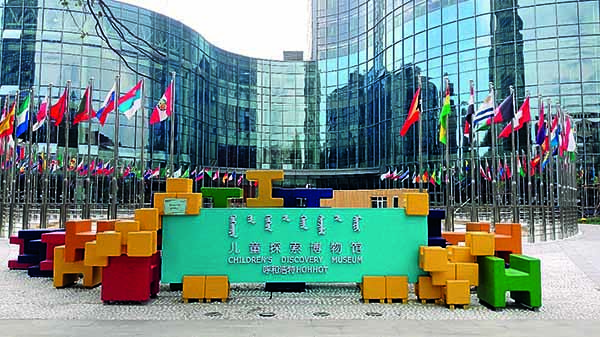Discovering Children’s Museum Education

The Laoniu Children’s Discovery Museum inside China National Children’s Center is one of the largest children’s museums in Beijing. It features exhibits and entertainment facilities for children up to age seven. Unlike the passive entertainment facilities in theme parks, the 2,400-square-meter museum is designed to blend knowledge about culture, society and science. The exhibitions combine interesting educational content to inspire children to think and explore actively.

Exploration Fun
After stepping into the museum with his mother for the first time, five-year-old Guoguo was instantly drawn to the climbing facilities resembling those found in amusement parks. He quickly climbed to the highest level seven to eight meters above the ground. Then, he noticed several children throwing foam blocks of various shapes into a glass tube and immediately joined in. His mother discovered that the whole climbing area was designed to be integrated with the glass tube, and long conveyer belts were installed on both sides. Several children and parents were transporting building blocks to the climbing area. As all of them worked together, the stacked blocks gradually formed a wall.
Zhao Yaqin, curator of the museum, explained that the project called “Construction Site,” combined hands-on experience with skills such as climbing, adding building blocks, transporting and collaborating to inspire children to explore architecture freely.

At the museum, “having fun” seems to be the ultimate goal for children. Each theme exhibition area integrates learning into a game by adding fun elements that enhance children’s cognitive abilities. “Happy Ball” is a favorite for children. They place balls on different conveyer belts to feed them into a big box overhead. When the box is filled with balls, it automatically opens, and the balls fall together. Eager to feel the balls falling on them, the children wait in groups below. The task subtly demands cooperation from children playing the game.

American Concept Comes to China
The idea of founding the discovery museum originated from Niu Gensheng, founder of Laoniu Foundation, during an environmental project tour in Hawaii at the end of 2011. By chance he visited the Hawaii Children’s Discovery Center in the United States, where exhibitions focus on experience and interaction. Contrasting traditional exhibition-themed museums, it focuses on catering to children’s hands-on exploration. After the visit, Niu decided to introduce the project to China, which led to the opening of the discovery museum.
At that time, the Magic Bean House Children’s Museum in Beijing was China’s only museum that integrated leading international educational ideas. Founded in 2010, the museum is in fact the country’s first children’s museum registered as a member of the Association of Children’s Museums. The idea to establish this museum popped into the head of its founder Zhang Ni when she was studying for a master’s degree in education at Columbia University. She was struck by the difference between Chinese and American educational concepts. After graduation, she raised the funds by herself and collaborated with professional teams in the United States and Singapore to establish the small experimental institution of only 500 square meters. Shortly after the Magic Bean House opened, Zhang wrote that exhibits of a successful children’s museum must interact with visitors in some way rather than just sit on display.
After extensive preparatory work involving Zhang, the Laoniu Foundation and Beijing Normal University established the Children’s Museum Research Center in China, and Zhang Ni was invited to serve as its executive vice-director. The organization directly pushed for the development of the Laoniu Children’s Discovery Museums in Beijing, Shanghai, Hong Kong and other regions and eventually became a leading educational research institution in China’s museum education for children.
As Zhang pointed out, unlike Western children’s museums funded mostly by non-governmental public welfare donations, the Laoniu Children’s Discovery Museums have received strong support from Chinese government agencies. For instance, the Beijing-based Laoniu Children’s Discovery Museum that opened in 2015 has received a special allocation of more than 20 million yuan (about US$3 million) from the central government. On May 31, 2018, with the support of the governments of Inner Mongolia Autonomous Region and Hohhot City, another Laoniu Children’s Discovery Museum began trial operation in Hohhot.

A Brighter Future
The museum project advocates the idea that a “children’s museum should not convey adults’ understanding of knowledge, but instead adapt to children’s growth patterns.” It provides a new method for improving and enriching the children’s education function of Chinese museums and a new idea for China’s early childhood education reform.
In 2015, China promulgated and enacted the Regulations on Museums, which lists education as the primary function of museums. This aligns with the international concept of museums. Zhang pointed out that traditional museums are also greatly influenced by children’s museums and have begun investing more into their educational role for children. She said that the Children’s Museum Research Center has been increasing cooperation with traditional museums in recent years and has conducted many training programs on designing exhibition projects suitable for children, which has achieved promising results.

As a form of extensional education, how will children’s museum education affect overall educational reform in China? Zhang believes that educational equity should be the primary concern. At present, the Laoniu Children’s Discovery Museums are making tremendous efforts in this regard. They have launched the “Children+365 Program,” which aims to help poor children, children with special diseases and other vulnerable groups enjoy children’s museums. Organizers hope that with guidance and education for parents, advanced educational concepts can enter every family.
In China, more and more attention has been placed on children’s museum education. Efforts to promote children’s museum education have created a better environment to meet the growing needs of children.
